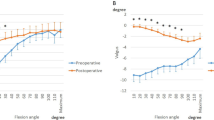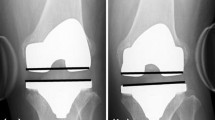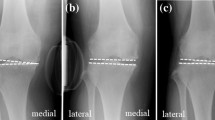Abstract
We performed stress arthrometric studies on 77 knees (71 patients) with total knee arthroplasty to determine the presence and magnitude of femoral abduction and adduction in knee extension. A total of 53 knees (49 patients) had posterior cruciate ligament-retaining (PCLR) prostheses, and 24 (22 patients) had PCL-substituting (PCLS) prostheses. The selected patients had successful arthroplasties with no clinical complications a minimum of 5 years after primary surgery. Each patient was subjected to a successive abduction and adduction stress test at 0°–20° of flexion using a Telos arthrometer. The mean values for abduction and adduction were 4.8° and 4.5° with a PCLR prosthesis, respectively, and 4.6° and 4.0° with a PCLS prosthesis. There were no statistical differences between PCLR and PCLS knees. The results suggest that approximately 4° of laxity in these directions is suitable in total knee arthroplasty for a satisfactory clinical outcome 5–9 years after surgery.
Similar content being viewed by others
Author information
Authors and Affiliations
About this article
Cite this article
Ishii, Y., Matsuda, Y., Ishii, R. et al. Coronal laxity in extension in vivo after total knee arthroplasty. J Orthop Sci 8, 538–542 (2003). https://doi.org/10.1007/s00776-003-0668-0
Received:
Accepted:
Issue Date:
DOI: https://doi.org/10.1007/s00776-003-0668-0




